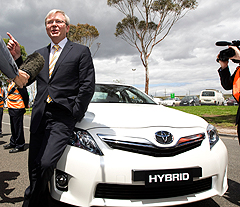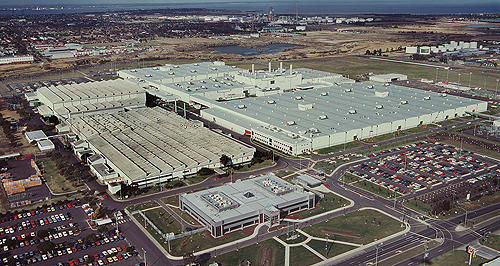Make / Model Search
News - ToyotaToyota engine plant threatenedUnder threat: Toyota's Altona Manufacturing Plant's engine facility is under cloud, due to the financial crisis and world over-capacity. Future of Toyota’s Altona engine plant – and 300 jobs – hanging on head office talks24 Dec 2009 THE fate of Toyota Australia’s engine plant is hanging in the balance as local management negotiates with head office in Japan for the necessary investment to re-tool for a new-generation engine for the next locally-made Camry by 2012. Australian senior executives of the world’s biggest car company are tense over the state of negotiations, which will decide the future of the 31-year-old engine factory that sits alongside the Toyota car assembly plant at Altona, in Victoria. “I understand the engine plant decision is still pending,” one Toyota senior executive told GoAuto. “Apart from that, I can’t say anything.” Toyota Australia spokesman Glenn Campbell today told GoAuto that the company was doing everything it could to secure investment for the engine project. He said the impact of the global financial crisis and excess capacity (at Toyota plants) had made securing new investments more difficult. Mr Campbell said no decision had yet been made on the new “AR” engine for Australia, and timing was not certain. “Toyota Australia will continue to manufacture the current AZ engine until the end of 2011,” he said.  Left: Prime minister Kevin Rudd with the first Camry Hybrid at the Altona factory. Left: Prime minister Kevin Rudd with the first Camry Hybrid at the Altona factory.Any decision not to revamp the factory for the new 2.5-litre four-cylinder 2AR-FE engine for the next, eighth-generation Camry would almost certainly doom the engine operation and, potentially, its 300 jobs, with the work going offshore, probably to Thailand. The engine plant decision almost certainly was a subject of discussion at the highest level when the prime minister Kevin Rudd, federal industry minister Kim Carr and Victorian premier John Brumby gathered at Altona for the recent Camry Hybrid line-off ceremony with Toyota executives earlier this month. The Altona factory last year turned out more than 114,000 2.4-litre four-cylinder engines for locally-made Camrys for customers in Australia and more than 20 export markets. Toyota’s exports in 2008 were worth almost $2 billion, with half of its car production going offshore, although numbers will be down this year. The 2.4-litre engine – which does not meet Euro 5 emissions restrictions – is being phased out around the world, replaced by the new-generation 2.5-litre four-cylinder that has already gone into production in the United States for the facelifted 2010 Camry and RAV4. That engine – developing up to 133kW compared with the current engine’s 117kW – is slated for production at numerous Toyota sites around the world, including Japan, China, Taiwan and Thailand. The latter is thought to be the most likely alternative source for the new engine for Australian-built Toyota cars. Toyota Motor Corporation executive vice president Yukitoshi Funo told journalists at the recent line-off ceremony for the new Camry Hybrid that Toyota Australia would need to work with Thailand to maximise export and manufacturing opportunities. In August, GM Holden closed its Australian four-cylinder engine plant with the cost of 500 jobs, although it still has its newer six-cylinder factory building the Alloytec V6 for Commodore and export markets. The long-term future of Ford Australia’s engine plant at Geelong is also clouded, although the company gave it at least a temporary reprieve when it decided to build a revised version of its venerable inline six instead of importing a V6 – for now. The Toyota engine plant future has been up for discussion since at least 2008 when Toyota spokesman Peter Griffin told GoAuto that the fate of the facility would be known within a year. It is now 18 months since that statement, and production start-up for the next generation Camry is as little as 18 months away. Toyota Australia will be arguing that any decision to shut local engine production would severely damage the viability of Toyota manufacturing in this country. It would drive up the imported content of the Camry, which at the moment is restricted to high-tech components such as transmissions and electronics. A decision to invest in local 2.5-litre engine production at Altona might also open the door to building the internal combustion part of the hybrid powertrain for the next generation Camy Hybrid that Toyota Australia hopes to make. GoAuto understands the hybrid powertrain – which has both petrol and electric motors – will be upgraded from the current 2.4-litre Atkinson cycle engine to the new 2.5-litre Atkinson cycle unit in the next Camry. That might also open up opportunities for Australian government aid under the federal government’s $1.3 billion green car innovation fund. Alternatives to making the Camry engine in Australia are difficult to see. Toyota phased out Corolla four-cylinder engine production in this country after it switched to imports for its top-selling small car in late 2001. It also imports the 3.5-litre V6 for its slow-selling Aurion. A business case for returning either of these or, indeed, any other engine would be difficult to make. However, Toyota is renowned for its endeavours to not take a backward step on its production bases around the world. When it was forced to take the unprecedented step to shut the Californian factory it shared with General Motors this year after the latter pulled out, leaving its Japanese partner in the lurch, Toyota grieved. In Australia, when demand for its local products fell as a consequence of the global financial crisis, Toyota Australia did not lay off one worker, instead giving its idle “team members” added skills training on “down days”. Toyota will also be mindful of the loss of face with the Australian government after much hoopla from prime minister Kevin Rudd – who recently visited Toyota’s headquarters in Nagoya, Japan, and then drove the first Camry Hybrid off the production line in Australia – and a $35 million grant to help fund the development of the Camry Hybrid. The Victorian government, which has also contributed to Toyota Australia development coffers, also will be keen to see the best outcome for the plant. Toyota’s Altona facility – which includes a foundry, panel stamping plant, paint shop and assembly lines, as well as the engine plant – employs about 3500 workers and injects hundreds of million of dollars into the Australian economy via wages and component purchases. The engine plant became the first Toyota manufacturing facility at the greenfield Altona site, in Melbourne’s inner west, in 1978. The car assembly began at Altona with Corolla in 1994. It was joined by Camry which shifted from the Port Melbourne plant a year later.  Read more |
Click to shareToyota articlesResearch Toyota Motor industry news |












Facebook Twitter Instagram